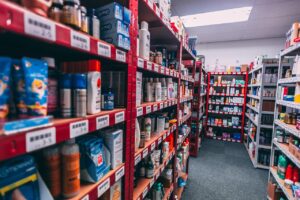Food And Beverage Inventory Management
Poor inventory management is silently killing your restaurant profits. Food waste piles up. Costs skyrocket. And before you know it, your margins vanish, so mastering food and beverage inventory management isn’t just a smart move—it’s a matter of survival for your restaurant.
A good inventory management system is important for restaurant owners and managers. To succeed, they need to keep track of what items come in and out of the storeroom and what is prepared in the kitchen. Having an accurate and up-to-date inventory system is vital for any food business. It helps reduce food waste, catch theft, and maintain the overall health of the restaurant.
Whether you run a small café or a high-volume kitchen, this guide gives you everything you need to take control: proven strategies, smart software tools, and actionable steps to track inventory, reduce waste, and boost your bottom line.

What Is Food and Beverage Inventory Management?
Food and beverage inventory management is the process of tracking, controlling, and optimising every ingredient and product that moves through your restaurant—from fresh produce to bottled wine. It ensures that what you purchase is used efficiently and not wasted.
When done right, inventory management is a powerful tool that can significantly lower food costs, reduce waste, improve margins, and keep customers happy. By ignoring proper inventory management, you risk issues such as excessive ordering, waste, theft, and incorrect financial documentation. Restaurants that don’t manage their inventory well risk losing money and may fail in the long run. With the right strategies and tools, you can change this and significantly improve your profits.

Why Inventory Control Is Crucial for Restaurant Success
Effective inventory control is a non-negotiable for any business, especially for restaurants that operate on slim margins. Every ounce of waste directly impacts profitability, making good inventory control a key driver of success for your restaurant.
Food Waste Stats (2025):
- Restaurants waste an average of 4–10% of purchased food (NRA, 2024 report).
- U.S. food service businesses generate over 11 million tons of food waste annually.
Inventory control can help you:
- Minimise food and beverage waste
- Track and control food costs
- Increase gross profit margins
- Hold staff accountable for losses or errors
The hospitality and food service sector in the United Kingdom throw away around 1.1 million tonnes of food each year. This figure encompasses waste from restaurants, pubs, hotels, and catering services. The UK produces around 10.7 million tonnes of food waste each year, with the HaFS sector accounting for about 10% of this total.
In contrast, the food service industry in the United States produces over 11 million tonnes of food waste each year. While the total waste amounts are similar to those in the UK, we must consider the population difference. The UK generates a high amount of food waste per person in the hospitality sector. This highlights the need for better inventory management and waste reduction strategies.
Food service companies in the UK can cut waste, save money, and help the environment by setting up strong inventory management systems, training their staff, and keeping track of waste.
Good systems also build a culture of responsibility. When staff know that stock is monitored, accuracy and care improve across the board.
The Ultimate Guide to Fast Food Restaurant Management Systems
Key Benefits of Using Inventory Management Software
Manual inventory tracking is outdated. Modern inventory software saves time and money by automating the process, reducing errors, and delivering insights that drive better decisions.
Top Benefits:
- Real-Time Stock Tracking: Know precisely what’s in inventory across multiple locations or storage areas.
- Automated Ordering and Alerts: Set par levels and let the system alert you when it’s time to reorder.
- CoGS Visibility: Track the Cost of Goods Sold by item, dish, or category to protect margins.
- Theft Prevention: Spot usage anomalies, missing items, or waste trends before they become expensive problems.
With intuitive dashboards and mobile access, managers can act quickly from anywhere—whether on the floor or at home.
Top Food and Beverage Inventory Systems for Restaurants (2025)
Choosing the right inventory system depends on your restaurant’s size, needs, and existing tech stack. Here are the top tools trusted by operators in 2025:
| Software | Best For | Pros | Cons |
| Toast | Full-service restaurants | POS + inventory + labor tracking in one platform | Slightly higher cost for small operations |
| MarketMan | Multi-location chains | Vendor mgmt, recipe costing, mobile app | Learning curve for some users |
| TouchBistro | Independent restaurants | Easy setup, solid reporting, integrates with POS | Limited features for large chains |
| Upserve | Fast-paced kitchens | Real-time analytics, food costing, mobile access | Best features only on premium plans |
| ApicBase | High-volume kitchens | Advanced analytics, wastage tracking, recipe scaling | More suited to enterprise-level ops |
Each platform offers a demo or trial—test them to see which matches your workflow.

How to Create a Food and Beverage Inventory List
An organised inventory list forms the core of effective stock management. Here’s a step-by-step way to build one:
Step-by-Step Guide:
- Categorise Inventory: Break it into groups—produce, dairy, meat, dry goods, beverages, non-food supplies.
- Define Units of Measure: Use standardised units (e.g., lbs, gallons, cases) for consistency.
- Assign Storage Locations: Label where items are stored (e.g., freezer, dry storage, bar).
- Set Par Levels: Determine ideal stock levels based on average usage and lead times.
- Build a Tracking Template: Use a spreadsheet, inventory app, or restaurant software.
Example Format:
| Category | Item | Unit | Par Level | Current Stock | Reorder? |
| Dairy | Milk | gal | 10 | 6 | Yes |
| Protein | Chicken | lbs | 30 | 28 | No |
Audit weekly or bi-weekly, and update your list after every inventory count.
How to Reduce Food Waste with Better Inventory Control
Food waste costs the industry billions every year. Here’s how to fight it with better inventory practices:
- Use FIFO (First In, First Out): Always use older stock first to avoid expiry-related waste.
- Label and Date Everything: Mark all incoming inventory with received and use-by dates.
- Track Waste Daily: Record spoiled or overcooked food to identify patterns.
- Control Portions: Use tools and SOPs to ensure consistency across every dish.
- Monitor Prep Levels: Prep what’s needed for service, not in bulk, for convenience.
Reducing food waste by a modest 5–10% can significantly boost profits without adjusting menu pricing to underscore the importance of effective inventory management in controlling costs and improving your restaurant’s financial health.
How to Control Food Costs in Purchasing and Receiving
Food cost management begins before ingredients enter your kitchen. Here’s how to gain control:
- Vendor Management: Build strong relationships, compare prices regularly, and negotiate volume discounts.
- Recipe Costing: Break down each dish by ingredient cost to find profitable and underperforming items.
- Forecasting: Use sales trends to anticipate demand and order only what’s needed.
- Check Deliveries: Always verify quantities and quality before signing off on invoices.
Pair purchasing best practices with inventory data for more accurate forecasting and cost control.
Inventory Best Practices for Restaurant Staff
Inventory isn’t just the manager’s job—it’s a team effort. Set your staff up for success:
- Assign Roles: Designate 1–2 staff members responsible for inventory tracking.
- Set a Schedule: Conduct counts during slow hours (e.g., before opening or after closing).
- Always Count in Pairs: Two sets of eyes reduce human error.
- Train on SOPs: Teach staff how to store, label, and rotate stock properly.
- Reward Accuracy: Incentivise clean counts and improvements over time.
A culture of accountability begins with setting clear expectations and providing ongoing training.
Related articles:
Best Restaurant Management Software UK
Fast Food Restaurant Management Systems
FAQ: Food and Beverage Inventory Management
Which is the best inventory software? Toast, MarketMan, TouchBistro, ApicBase, and Upserve are among the top-rated systems in 2025. The right choice depends on your restaurant size, needs, and budget.
How do restaurants control inventory? They use digital inventory systems, count stock regularly, set par levels, monitor waste, and train staff to follow standard procedures.
How to make a restaurant inventory list? Start by categorising items, setting units of measure, listing storage locations, and entering current counts into a template. Review and update it weekly.
Happy Restaurant Staff: 20 Tips On How To Make Your Employees Happy


